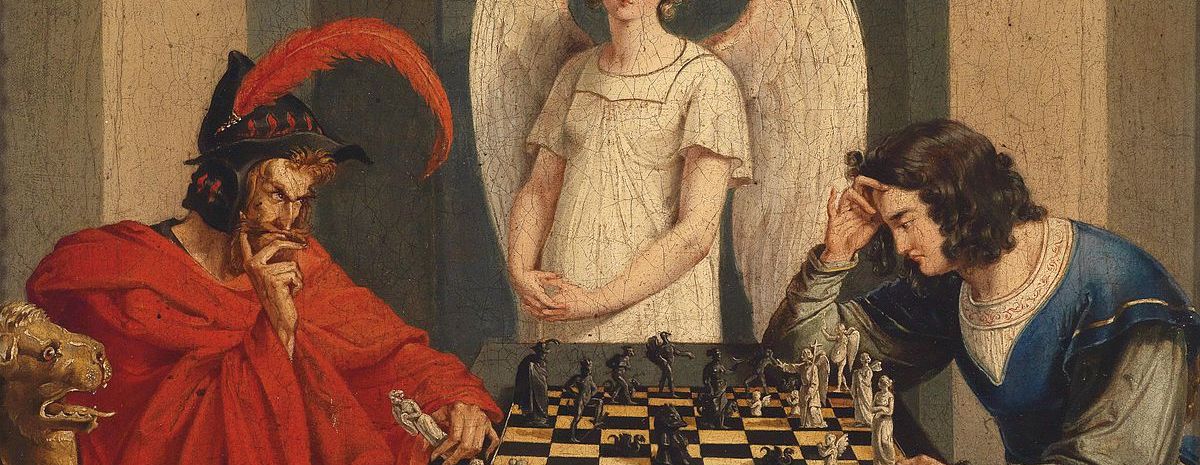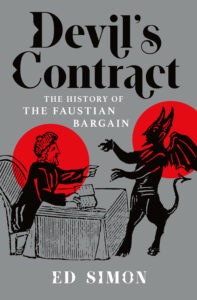
A Deal With the Devil: What the Age-Old Faustian Bargain Reveals About the Modern World
Ed Simon on "The Most Important Story Ever Told," That of Humanity's Transactional Relationship With Evil
The legend of the Devil’s contract is the most alluring, the most provocative, the most insightful, the most important story ever told. It concerns a humanity strung between Heaven and Hell, the saintly and the satanic; how a man could trade his soul for powers omnipotent, signing a covenant with the Devil so that he could briefly live as a god before being pulled down to Hell. Frequently associated with Christopher Marlowe’s Doctor Faustus, that Elizabethan play wasn’t the origin of that myth, but his is certainly a sterling example of that eternal script. Yet long before that Renaissance play and long afterwards, we can find the inky traces of Faust’s damned signature in a multitude of works both high and low, canonical and popular. More disturbing than that is the way that the Devil’s hoof-prints can be found across the wide swatch of history, in our willingness to embrace power and engage in exploitation, to summon self-interestedness and to conjure cruelty.
*
Examine some of those Mephistophelean hoof-prints as discovered at a Southwark, London construction site in 1989. The Rose Theatre, where Marlowe’s play premiered in the late sixteenth century, was torn down in 1606 where it would be subsumed beneath layers Jacobean, Interregnum, and Restoration, then Hanoverian, Regency, and Victorian, until Thatcher-era contractors building a soulless corporate office tower uncovered the bottom level of this strata of London history. Workers sifting through dirt found the tell-tale signs of a theater, from the preserved remains of charred hazelnut shells once sold as snacks to the broken clay pots used to collect tickets. The ruins of the theater once again had sunlight upon them. Now the remains of the Rose are within the basement of said soulless office tower looming above the Thames, the rare active archeological site which also invites audiences to enjoy a show atop the detritus of the theater where plays were first performed four centuries ago.
There are few archetypal scripts in our culture as essential as the legend of a man selling his soul to the Devil.
The earliest performances of Doctor Faustus were dogged by supernatural associations; audience members claimed that during the scenes of magical conjuration the playwright’s words compelled demons to appear. “How am I glutted with conceit of this!” marvels Faustus in the first act of Marlowe’s play, “Shall I make spirits fetch me what I please, / Resolve me of all ambiguities, / Perform what desperate enterprise I will?” Ostensibly a description of the dark arts’ powers, but applicable to any art’s strange abilities, certainly those of the theater. How did Marlowe differ from Faustus? For he could compel spirits of the imagination to fetch what he wanted, to perform what he wanted, to generate a seeming universe from nothing but words and gestures. And, like Faustus, Marlowe too would have his punishments, stabbed to death through the eye in a Deptford tavern, purportedly after arguing over the bar tab a year after the premier of his most celebrated play.
Should subsequent legends be trusted, magic apparently happened in what today looks like scarcely more than a pile of sifted rubble. During performances of Faustus, Latin incantations and magical circles inscribed upon the stage floor were said to be capable of conjuring forth demons just as if the actors were necromancers. From those circles traced with a staff into the dirt of the floor, it was believed that a wizard could summon the citizens of Hell to appear—Azazel with his curved goat horns, the snorting, red-eyed bull Moloch, or insect-winged Beelzebub, his mandibles sticky with blood. Maybe even Mephistopheles, that demon novel to the Faust legend, who first appears as if a decomposing corpse with flesh decayed away from his skull and maggots sifting through his eye-sockets and nose, only to later conduct himself in the more respectable shape of a Franciscan mendicant. Now, for any visitor to the theater built upon the corpse of its predecessor, the thin line of lurid blood-red neon light which demarcates the rough circle of the Rose theater’s original foundation appears unnervingly like those magic circles affixed with strange alchemical symbols and numbers in which Renaissance necromancers would attempt to call upon all of the cursed demons of Pandemonium and where Satan came hidden on opening night to critique how well he’d been rendered by the playwright.
When I attended a performance at the Rose of another Renaissance play known for its occult themes—think Scotland, witches, murdered kings—it was that neon light along the periphery of the darkened, damp, and musty smelling subterranean hole that most kept my attention, that luminescent circle offset in the darkness of the basement’s most distant corners, bordered by the rubble of centuries still being sifted. The production was good, albeit in the now de rigueur tic for modernization, but sitting on the rafters in that basement that smelled of water and earth, the Weird Sisters and Macbeth were far less fascinating to me than what I couldn’t see, just somewhere on the dark edge of vision, beyond a ribbon of neon intended to let me know where the walls of the Rose had once been.
Imagining that premier of Doctor Faustus more than four hundred years ago—and all of that is inaccessible to us in that strange and distant country of the past—I couldn’t help but entertain those diabolical legends about Marlowe’s audience that evening. There, in that black space above the periphery, was that where Satan sat on the rafters, disguised as a ruffled Elizabethan gentleman in black and red velvet? But no, Satan is not real, those stories are antitheatrical Puritan agitprop, folktales intended to frighten the credulous. No demons were conjured in any production of Faustus, for they are but characters, and characters are mere fiction. And yet, when the wizard’s clown reads “Sanctabulorum…Mephistopheles” (nonsense Latin, incidentally) and a demon does appear, even the skeptic in me wonders what an infernal story deftly told may conjure.
The morning following that 2013 production of Marlowe’s play, I traveled to Deptford to meet the playwright himself. When Marlowe was martyred in an upstairs room of Eleanor Bull’s tavern, Deptford was part of Kent and was regarded as a sordid, distant environ of the capital, a seedy dockyard town south of London governed by dissolute merchants. Walking down its High Street, I found that four centuries have only moderately softened that reputation. Making my way past claustrophobic pubs with their bubbled-windows and the dark abyss of their propped-open doors, the greasy fried odor of fish and chip shops and the tinny Brit Pop playing within, I spent the better part of an hour vainly looking for St. Nicholas’s churchyard while nervously eyeing grey skies and the cool wind blowing in off the Thames, for in those days I didn’t avail myself of a smartphone’s convenience.
Though it was July, in my memory it was only ever October, Deptford a morass of confusing, crooked, coble-stoned streets punctuated by centuries-old dissenting churches and small brick rowhouses whose curtains were tightly pulled shut. Surely there were green leaves on the trees, but in my memory, all of those branches are skeletal, bones stripped of flesh withered beneath a sky the color of brackish water. My Gothic disposition only intensified after I finally found Marlowe’s graveyard, the opposing redbrick columns marking the entrance to the grounds topped by a pair of grinning skulls hewn from stone, their toothless grins and eyeless sockets a memento mori installed a century after the most famous resident was tossed into an anonymous pauper’s tomb. A redbrick, ivy-covered wall demarcates the graveyard from the realms of the living, upon which is affixed a small white marble plaque mourning the poet’s “untimely death,” while proclaiming that somewhere within this earth are the remains of Marlowe, his bones intermingled with other subjects in the kingdom of death. “Cut is the branch that might have grown full straight” reads Marlowe’s epitaph. It’s from Doctor Faustus.
Examining the dual voids in the carved skulls welcoming me to St. Nicholas’s reaffirmed what I found so fascinating about this story of a contract with the Devil, for walking upon that hallowed ground, atoms of Marlowe now slick with the dirt on the soles of my shoes, and the part of me that is skeptical of skepticism couldn’t help but feel antique occult enthusiasms, that sense that there may be something beyond this veil of our reality, something that we can access but that we can’t control.
*
My desire to write a cultural history of the Faust legend goes back a few years earlier than my pilgrimage to the Deptford churchyard, around the time that I attended an adaptation of the play entitled faustUS staged by the theater collective 404 Strand in my hometown of Pittsburgh. Basing the script on the shorter, so-called “Text A” of Marlowe’s play, a tauter and more cryptic work that cuts the slapstick that mars more traditional productions of Doctor Faustus, the performance was hallucinatory, ritualistic, psychedelic, incantatory. A work of conjuration. With the audience invited to sit in an ad hoc theater-in-the-round constructed on the stage of the Kelly Strayhorn Theater, we all faced a rusted iron-cage in which the action of the play would be set. I was in the front row.
My most distinctive memory of that performance was the actor who played Faust, shirtless and sinewy, glistening with sweat beneath the oppressive stage lights, hoisting a shaggy, bestial mask of a horn-twisted ox over his head, and wildly gesticulating to thrash metal so loud that my fillings were humming, the necromancer then taking a full loaf of white bread out of its antiseptic bag and shredding it into the gapping maw of the bovine mask, bits of spongy whiteness spraying onto all of us sitting in the front row. It was bizarre and impossible not to watch, part avant-garde performance art and part pagan ceremony. The physicality of the performance made it seem otherworldly, alien, and dangerous. Walking out into the autumn air of Pittsburgh’s East Liberty, a neighborhood of Gilded Age high-rises and Gothic skyscraper cathedrals that are intercut with alleyways and corner bars, I vowed that one day I would sign a contract to pen my own Faustian tale. That was the only production of Marlowe’s play that I’ve seen. The sort of thing Satan might just come to see if he was wondering how he might be depicted.
Marlowe’s scant seven plays are seldom produced today; the 2007 staging of Tamburlaine the Great mounted by the Shakespeare Theater Company in Washington DC or the riveting film adaptation of Edward II directed by Derek Jarman in 1991 notwithstanding. When compared to his contemporary, competitor, and possible colleague William Shakespeare, who four centuries after his death has productions mounted every day, of every year, in every major city on Earth, who is not just a writer but The Bard, the standard by which capital-L Literature is evaluated, Marlowe can seem an afterthought, a footnote, even if he is distantly the second most popular Elizabethan playwright whose work is still performed.
Yet I’d argue that Marlowe, whose mighty blank verse prefigured and in many instances surpassed that of The Bard, is every bit the equal of Shakespeare. Between the two, Marlowe is in some ways the more antiquated, a man who despite his reputation for atheism had an inclination toward the Medieval. That, however, is what ironically gave the arch-heretic such a profound sense of the numinous, for whatever his own relation to the Lord, Marlowe can’t be accused of not taking an interest in the holy and transcendent, the sacred and the ecstatic. Of course Shakespeare had his own sense of the numinous—it was impossible not to in the Renaissance. But as a kind of divine blasphemer, Marlowe endures as a parallel universe Bard, a kind of shadowy counter-Shakespeare, the great, queer, sacrilegious poet and playwright of damnation.
Faust’s story has always been estimably modern, perhaps the first modern story.
Tamburlaine the Great’s iconoclasm and The Jew of Malta’s irreverence aside, no work of sacred heresy in Marlowe’s oeuvre is as profound as Doctor Faustus. His quisling scholar selling his birthright for the pottage of trickery and illusion may be modernity’s operative metaphor, but Marlowe was hardly the originator of the myth. As you’ll read in the chapters ahead, Marlowe adapted the historical Johann Faust from German folkloric tradition, though the myth of a contract with Satan existed centuries before that unfortunate alchemist first crossed potassium nitrate with sulfur. Nor of course was Marlowe’s rendition the final word, as thousands of permutations of the basic story have been produced over the half-millennium, from Goethe to the musical Damn Yankees, Thomas Mann to the Dixie-fried pablum of the execrable Charlie Daniels Band number “The Devil Went Down to Georgia.” High culture like Franz Liszt’s Faust Symphony and Gustav Mahler’s Symphony No. 8; pop culture from the comic book Ghost Rider to the Jack Black flick Tenacious D in the Pick of Destiny.
“The figure of Faust is—after Christ, Mary, and the Devil—the single most popular character in the history of Western Christian culture,” writes Jeffrey Burton Russell in his classic Mephistopheles: The Devil in the Modern World. And of those characters, Faust is the most fully human to us, in his arrogance and his failure, his negotiations and his capitulations, in the whole litany of abuse which the cankered soul is capable of inflicting upon itself. Russell’s contention is far from hyperbole, and amending the word “character” to “narrative,” I’d say that there are few archetypal scripts in our culture as essential as the legend of a man selling his soul to the Devil. Thousands of works of literature and film, music and art, grapple with the bargain whereby somebody trades what’s most human for power or wealth, influence or knowledge. Only the myth of Adam and Eve being cast out of Eden competes with Faust in terms of influence, and that story is arguably an early variation on the Devil’s contract.
Which is what makes the relative dearth of critical treatments of the variable legend so surprising. There are to be sure a multitude of books, tracts, monographs, and papers on the best-known versions of the legend; academic appointments have been made based on studies of Marlowe, and tenure has been secured with an expertise on Goethe, but the whole megillah as it pertains to Faust, whether that’s his name or we call him something else, has yet to be told. My own modest attempt is this book, for though Marlowe, Goethe, and Mann might all be inside, it’s not a book about Marlowe, Goethe, and Mann, it’s not even really a book about a singular character named “Faustus.”
And though it is ostensibly a history, and this narrative moves onward rather chronologically, I prefer to think of the story it tells as being about a character who is outside of time, who lives parallel to past, present, and future. An eternal story. Because what this book is concerned with are the implications— culturally, politically, theologically—of these highly symbolically charged narratives concerning the abjuration of a soul, of the ceding of what’s intrinsic to us, of the capitulations and negotiations which make up any failed life, which is to say every life. More than a history, then, Devil’s Contract is an account of what it means to be human in all of our failings.
Increasingly an account of humanity right now. For all the legend’s archaicism, the muttered Latin and the alchemical conjuration, Faust’s story has always been estimably modern, perhaps the first modern story. Unlike Adam and Eve, with their inscrutable Bronze Age story composed in an idiom so ancient and foreign that centuries of theologians have disagreed on what the implications of each facet of the tale might mean, the details in the Faust legend are inescapably of our time. This is, after all, the story of a contract. The dénouement of most versions of the Faust story involves the signing of a legally binding document, an experience foreign to the authors of Genesis but replete in our own lives, whether interacting with human resources or clicking on an agreement with our phone company. Faust’s tale may deal in the numinous and the transcendent, but it’s also about bureaucracy and paperwork, our contemporary hell and its sacrament, respectively. We recognize Faust in a manner that no character in the Bible can ever be our contemporary.
An issue of signing on the dotted line is superficiality when it comes to Faust’s significance to modern readers, however, because more than any other myth the tale of the Devil’s contract is a succinct encapsulation of the human predicament over the past five centuries, right as modernity was gestated, born, thrived, and is now in the throes of its own death.
*
Marlowe staged his play at the very beginning of what is increasingly being called the Anthropocene, the geological epoch in which humanity was finally able to impose its will (in an almost occult manner) upon the earth. There are costs to any such contract, as the wisdom of the legend has it, so that it’s worth considering after five centuries of human domination of the planet that we might now be facing our own collective appointment at Deptford. We seem to finally be facing the final act, the apocalyptic tenor of our times, from climate change to nuclear brinkmanship making the continued survival of humanity an open question, our sad predicament the result of hubris, and greed, and vainglory. It may be appropriate to rechristen this age the Faustocene. Because whether or not the Devil is real, his effects in the world are. When it comes to “truth” and “facts,” the two words are not synonymous, and I wouldn’t at all be surprised if I could make out the smoke of some devilish chimera beyond the neon-line of the Rose Theater, deep within a darkness so all-encompassing that not a squib of light is capable of escaping.
__________________________________

Excerpted from Devil’s Contract: The History of the Faustian Bargain by Ed Simon. Copyright © 2024. Available from Melville House Publishing.
Ed Simon
Ed Simon is the Public Humanities Special Faculty in the English Department of Carnegie Mellon University, a staff writer for Lit Hub, and the editor of Belt Magazine. His most recent book is Devil's Contract: The History of the Faustian Bargain, the first comprehensive, popular account of that subject.












